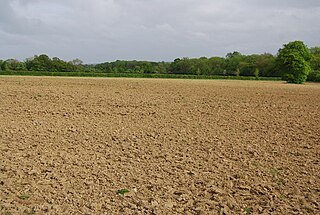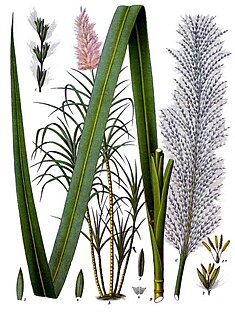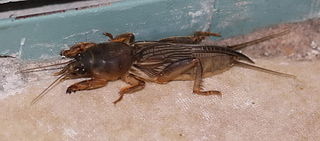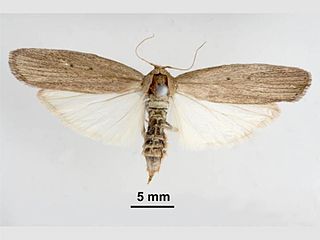
The cane toad, also known as the giant neotropical toad or marine toad, is a large, terrestrial true toad native to South and mainland Central America, but which has been introduced to various islands throughout Oceania and the Caribbean, as well as Northern Australia. It is a member of the genus Rhinella, which includes many true toad species found throughout Central and South America, but it was formerly assigned to the genus Bufo.

Crop rotation is the practice of growing a series of different types of crops in the same area across a sequence of growing seasons. It reduces reliance on one set of nutrients, pest and weed pressure, and the probability of developing resistant pests and weeds.

In agriculture, monoculture is the practice of growing one crop species in a field at a time. Monoculture is widely used in intensive farming and in organic farming: both a 1,000-acre cornfield and a 10-hectare field of organic kale are monocultures. Monoculture crops have allowed farmers to increase efficiency in planting, managing, and harvesting, mainly by facilitating the use of machinery in these operations, but monocultures can also increase the risk of diseases or pest outbreaks. Diversity can be added both in time, as with a crop rotation or sequence, or in space, with a polyculture or intercropping.

Moths are a paraphyletic group of insects that includes all members of the order Lepidoptera that are not butterflies, with moths making up the vast majority of the order. There are thought to be approximately 160,000 species of moth, many of which have yet to be described. Most species of moth are nocturnal, but there are also crepuscular and diurnal species.

Vicia sativa, known as the common vetch, garden vetch, tare or simply vetch, is a nitrogen-fixing leguminous plant in the family Fabaceae. Although considered a weed when found growing in a cultivated grainfield, this hardy plant is often grown as green manure or livestock fodder.

Fallow is a farming technique in which arable land is left without sowing for one or more vegetative cycles. The goal of fallowing is to allow the land to recover and store organic matter while retaining moisture and disrupting the lifecycles of pathogens by temporarily removing their hosts.

The Crambidae are the grass moth family of lepidopterans. They are variable in appearance, the nominal subfamily Crambinae taking up closely folded postures on grass stems where they are inconspicuous, while other subfamilies include brightly coloured and patterned insects which rest in wing-spread attitudes.

Dermolepida albohirtum, the cane beetle, is a native Australian beetle and a parasite of sugarcane. Adult beetles eat the leaves of sugarcane, but greater damage is done by their larvae hatching underground and eating the roots, which either kills or stunts the growth of the plant. The beetles can also be found in the Philippines and are known there by the local name salagubang.

Sugarcane or sugar cane is a species of tall, perennial grass that is used for sugar production. The plants are 2–6 m (6–20 ft) tall with stout, jointed, fibrous stalks that are rich in sucrose, which accumulates in the stalk internodes. Sugarcanes belong to the grass family, Poaceae, an economically important flowering plant family that includes maize, wheat, rice, and sorghum, and many forage crops. It is native to the warm, temperate tropical regions of India, Southeast Asia, and New Guinea. The plant is also grown for biofuel production, especially in Brazil, as the canes can be used directly to produce ethyl alcohol (ethanol).
Ratooning is the agricultural practice of harvesting a monocot crop by cutting most of the above-ground portion but leaving the roots and the growing shoot apices intact so as to allow the plants to recover and produce a fresh crop in the next season. This practice is widely used in the cultivation of crops such as rice, sugarcane, banana, and pineapple. Ratoon crops cannot be perennially renewed, and may be harvested only for a few seasons, as a decline in yield tends to occur due to increased crowding, damage by pests and diseases, and decreasing soil fertility.

Gryllotalpa orientalis is a species of mole cricket in the family Gryllotalpidae, commonly known as the oriental mole cricket. It is found in much of Asia and Australasia. At one time, this species was misidentified as G. africana and thought to have a widespread distribution in both Africa and Asia, but in the 1980s, G. orientalis was recognised as a separate species. It is a polyphagous pest, damaging crops by gnawing their roots.

Eldana is a genus of moths of the family Pyralidae containing only one species, the African sugar-cane borer, which is commonly found in Equatorial Guinea, Ghana, Mozambique, Sierra Leone and South Africa. Adults have pale brown forewings with two small spots in the centre and light brown hindwings, and they have a wingspan of 35mm. This species is particularly relevant to humans because the larvae are a pest of the Saccharum species as well as several grain crops such as sorghum and maize. Other recorded host plants are cassava, rice and Cyperus species. When attacking these crops, E. saccharina bores into the stems of their host plant, causing severe damage to the crop. This behavior is the origin of the E. saccharrina's common name, the African sugar-cane borer. The African sugar-cane borer is a resilient pest, as it can survive crop burnings. Other methods such as intercropping and parasitic wasps have been employed to prevent further damage to crops.

Tebufenozide is an insecticide that acts as a molting hormone. It is an agonist of the ecdysone receptor that causes premature molting in larvae. It is primarily used against caterpillar pests.
Chilo infuscatellus, the yellow top borer or sugarcane shoot borer, is a moth in the family Crambidae. It was described by the Dutch entomologist Samuel Constantinus Snellen van Vollenhoven in 1890. It is found in India, Myanmar, Tajikistan, Afghanistan, Korea, Taiwan, Malaysia, the Philippines and on Java and Timor.
Bissetia steniellus is a moth in the family Crambidae. It was first described by the British entomologist George Hampson in 1899. It is found in India and Vietnam where it is commonly known as the Gurdaspur borer because the larvae bore their way into and feed on the stems of sugarcane.
Scirpophaga nivella is a moth in the family Crambidae. It was described by Johan Christian Fabricius in 1794. It is found in southern Asia from the Indian Subcontinent in the west to southern China in the east, south to New Guinea and Australia, including New Caledonia and Fiji. Some sources have affixed the common name "sugarcane top borer" to it, despite it not being found in sugarcane, because they are confused with the species Scirpophaga excerptalis, which is an actual borer in the tops of sugarcane. Another newer common name that has been invented for these moths is "white rice borer".
Epiricania melanoleuca is a moth in the family Epipyropidae. It was described by Thomas Bainbrigge Fletcher in 1939. It is found in India, where its larvae are external parasitoids of the sugarcane planthopper. It has been used in biological pest control against this pest.

Neoscapteriscus vicinus, the tawny mole cricket, is a species of insect in the mole cricket family, Gryllotalpidae. Colombian insect taxonomist Oscar Cadena-Castañeda studied specimens of the genus that had been called Scapteriscus, and decided that it included two groups; a smaller group and a larger group that he named Neoscapteriscus in 2015. It is native to South America and also occurs in the Southern United States, where it arrived as a contaminant of ship's ballast around 1900. North American mole cricket taxonomists agreed with his decision and altered Orthoptera Species File Online accordingly.
Sturmiopsis inferens is a species of fly in the family Tachinidae. It is native to Asia and is a parasitoid of various moth species whose larvae feed inside the stems of sugarcane, rice and other large grasses, including the Gurdaspur borer and the sugarcane shoot borer.
Pyrilla perpusilla, commonly known as the sugarcane planthopper, is a planthopper in the family Lophopidae. It is native to Asia where it feeds on grasses and other plants and is a major pest of sugarcane and sorghum.













